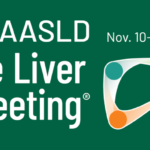Editor’s Note:
Chronic hepatitis B is the leading cause of liver disease in Chinese children, posing a serious threat to their health. The “Sprout” project is China’s first large-scale real-world study focusing on antiviral treatment for chronic hepatitis B in children. Led by Dr. Hongfei Zhang’s team, with Shenzhen Third People’s Hospital as the main center, the project is a charitable initiative initiated by the Beijing Chen Jumei Foundation. On November 10, 2023, the first day of the 2023 American Association for the Study of Liver Diseases Annual Meeting (AASLD 2023), Dr. Hongfei Zhang’s team from the Chen Jumei Medical Group presented the latest stage data of the “Sprout” project. The team’s detailed introduction to the project and its progress is shared below.

Chronic hepatitis B (CHB) poses a serious threat to children’s health, ranking as the primary cause of liver disease in Chinese children [1]. With the widespread use of the hepatitis B vaccine, the risk of CHB infection in children has significantly decreased. However, nearly 2 million children in China still test positive for HBsAg [2-3] and require specialized diagnosis and treatment. After HBV infection in children, some may experience disease progression, with some even developing into cirrhosis and liver cancer [4]. If not promptly treated, pediatric CHB not only affects the child’s physical health but also becomes a significant reservoir for adult hepatitis B in China. Most cases of chronic HBV carriers and liver cancer in adults in China originate from HBV infection during childhood [5].
To accumulate real-world research evidence for antiviral treatment of pediatric chronic hepatitis B, provide a basis for standardizing the diagnosis and treatment of pediatric CHB in China, and assist more children and families in coping with the challenges of CHB, the Sprout project responded to the “Healthy China 2030” plan and was initiated in 2021 through the joint efforts of Chinese experts.
Project Concept
The “Sprout” project – a research project on antiviral treatment for pediatric chronic hepatitis B – is China’s first large-scale real-world study focusing on this condition. Led by Dr. Hongfei Zhang’s team, with Shenzhen Third People’s Hospital as the main center, the project is a charitable initiative for pediatric chronic hepatitis B patients initiated by the Beijing Chen Jumei Foundation.
The project aims to explore and optimize antiviral treatment regimens through prospective cohort studies, enabling Chinese children with chronic hepatitis B to overcome the challenges of the disease. The goal is to ensure that pediatric chronic hepatitis B patients are diagnosed and treated promptly, comprehensively, and early to maximize the benefits of treatment. With the support of the Sprout project, the team has also established a professional training platform, fostering a group of specialized doctors in pediatric CHB antiviral treatment to provide professional medical services to more children with chronic hepatitis B.
The project plans to include 1,900 cases of pediatric chronic hepatitis B patients in three categories: initial treatment, nucleoside (acid) analog (NA) treatment, and patients with normal ALT levels. The patients, aged 3 to 18 years, are HBsAg positive and willing to undergo NA monotherapy or combined pegylated interferon alpha-2b (PEG IFNα-2b) treatment for 96 weeks according to their own or their guardian’s preferences.
Latest Developments
As of now, the Sprout project has screened 1,490 patients, with 1,264 valid cases. Over 90% of the children (1,163 cases) have adopted the treatment of PEG IFNα-2b combined with NA. The abstract presented at AASLD 2023 reports the analysis results of patients who completed at least 48 weeks of treatment by April 13, 2023 [6].
This analysis included 197 children who met the inclusion criteria and completed 48 weeks of treatment (NA monotherapy group, n=13; PEG IFNα-2b combined treatment group, n=184). The average age of all patients was 7.7 years, with 56.9% being male, 89.8% HBeAg positive, and 90.3% HBV DNA positive.
In the overall population, the HBsAg clearance rates at 48 weeks for the PEG IFNα-2b combined treatment group and the NA monotherapy group were 25.0% and 7.7%, respectively. Among initial treatment patients, the HBsAg clearance rates at 48 weeks for the PEG IFNα-2b combined treatment group and the NA monotherapy group were 30.1% and 0%, respectively. The average HBsAg levels of both groups gradually decreased during treatment, but the combined treatment group showed a significantly larger reduction. The average reductions in HBsAg levels at 48 weeks for the overall population and initial treatment patients were 1.6 and 1.8 log10 IU/mL, respectively.
In the overall population, the HBeAg clearance rates at 48 weeks for the PEG IFNα-2b combined treatment group and the NA monotherapy group were 19.6% and 0%, respectively, and the HBV DNA conversion rates were 71.2% and 66.7%, respectively. Among initial treatment patients, the HBeAg clearance rates at 48 weeks for the PEG IFNα-2b combined treatment group and the NA monotherapy group were 22.1% and 0%, respectively, and the HBV DNA conversion rates were 67.1% and 60.0%, respectively. Both monotherapy and combined treatments were well-tolerated.
The results demonstrate that PEG IFNα-2b combined treatment in HBV-infected children achieves higher rates of HBsAg and HBeAg clearance compared to NA monotherapy. The HBV DNA conversion rates between the two groups are similar. Antiviral treatment based on PEG IFNα can help children with chronic hepatitis B pursue clinical cure more effectively.

Researchers’ Comments:
In the treatment of pediatric chronic hepatitis B (CHB), Chinese experts have been continuously improving the deficiencies in the field through their efforts. Represented by Dr. Hongfei Zhang, Chinese experts have accumulated a wealth of experience in the treatment of pediatric CHB. Starting from short-acting interferons, they have gained profound insights. Children with CHB often respond better to interferons than adults, and the likelihood of achieving clinical cure increases with younger age at the start of treatment.
With the introduction of nucleoside analogs (NA) and pegylated interferon, more treatment options have become available for pediatric CHB. Increasing clinical practice evidence shows that combination therapy, primarily based on pegylated interferon, can provide better benefits for pediatric CHB patients, leading to higher rates of clinical cure. The latest interim results from the Sprout project further support this conclusion.
As treatment progresses, Chinese experts have gained a deeper understanding of CHB, with an increasing focus on the treatment of pediatric CHB. Each update of the Chinese Chronic Hepatitis B Treatment Guidelines has made certain adjustments to the treatment of this specific population. In the latest 2022 edition, the recommended opinion emphasizes a more proactive approach to antiviral indications for children aged 1 to 7 with HBV DNA positivity and normal ALT, even in the absence of liver histology examination results. This consideration is made under the premise of full communication and informed consent.
With the advancement of the Sprout project, we look forward to more data confirming that under combined treatment, primarily using pegylated interferon, the cure rate of pediatric CHB can be further improved. This approach may yield better treatment efficacy in adulthood, with easier control of adverse reactions and lower cost investment, benefiting more children and families.
References:
1. Zhang HF, Yang XJ, Zhu SS, et al. A study of liver histopathology and clinical manifestations in 1,020 cases of pediatric liver biopsy[J]. Chinese Journal of Pediatrics, 2002, 40(3):131-134.
2. Cui F, Shen L, Li L, et al. Prevention of Chronic Hepatitis B after 3 Decades of Escalating Vaccination Policy, China[J]. Emerging Infectious Diseases, 2017, 23(5):765-772.
3. National Bureau of Statistics of the People’s Republic of China. China Statistical Yearbook – 2015[Z]. Beijing: China Statistics Press, 2015.
4. Wen WH, Chang MH, Hsu HY, et al. The development of hepatocellular carcinoma among prospectively followed children with chronic hepatitis B virus infection[J]. Journal of Pediatrics, 2004, 144(3):397-399.
5. Zhang HF. Relevant issues in interferon treatment of pediatric hepatitis B[J]. Chinese Journal of Hepatology, 2002, 10(2):140-141.
6. Zhang H, Ouyang W, Zeng Y, et al. The efficacy of antiviral therapy for HBV-infected children: a multicenter real-world study (SPROUT Project) – an interim analysis. AASLD2023. Poster 1449-C.


